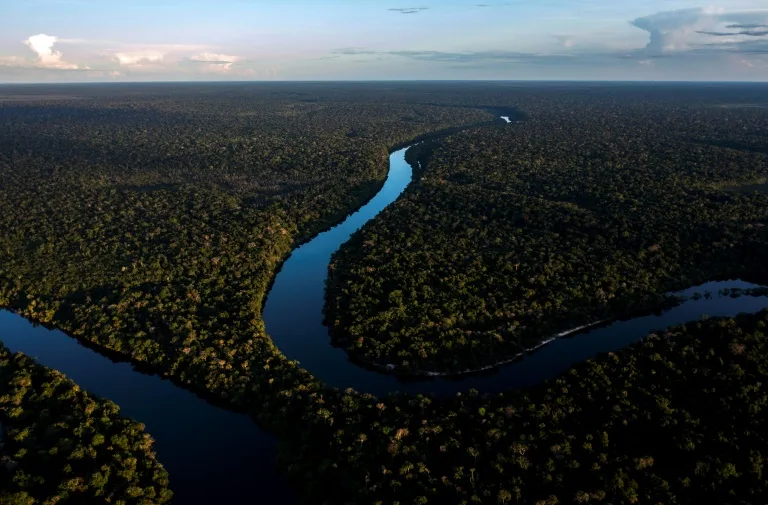The European Union is betting heavily on storing carbon to facilitate a less painful green transition, as it grapples with a barrage of resistance to its climate policies.
But while the nascent carbon capture industry believes it holds the key to warding off climate catastrophe, environmental activists warn of the dangers of technologies still relatively untested on a large scale.
Capturing and storing carbon dioxide means removing it from the atmosphere and pumping it into mountains or deep underground -- or reusing it to produce synthetic fuels and plastics for instance.
The European Commission this week recommended cutting the 27-nation bloc's greenhouse gas emissions by 90 percent by 2040, as a milestone toward becoming carbon neutral by 2050.
Mindful of asking too much too quickly of Europe's businesses and households -- which are already facing a cost-of-living crisis -- the EU's plan would involve capturing 280 millions tonnes of carbon per year by 2040, two-thirds of it stored and a third reused.
"There are certain sectors where processes are particularly hard to adapt, and changes are costly to implement," said the EU's green policy chief Maros Sefcovic.
Accelerating the deployment of carbon capture and storage technologies would enhance "the competitiveness of our industry" and "ensure that the transition is done in a socially fair manner", he said.
Steel, waste incineration and cement are all seen as candidates for this "carbon management strategy" -- which revolves around trapping carbon dioxide generated by factories or by gas or thermal power plants.
"When you really do the hard numbers on how to reach net zero, it becomes unavoidable," said Toby Lockwood of the Clean Air Task Force, a think tank.
The process has already begun.
Between them, EU member states aim to be storing at least 50 million tonnes per year by 2030, with an EU Innovation Fund supporting capture-storage projects that should have a capacity of 10 million tonnes a year from 2027.
But the infrastructure still needs to be built, including pipelines to transport carbon.
Around 19,000 kilometres (12,000 miles) of pipes would be necessary by 2040, requiring investments of around 16 billion euros ($17 billion).
"You can only get so far with renewable electrons and with renewable hydrogen, and you cannot get to the last mile," said Joop Hazenberg, EU director at the Carbon Capture and Storage Association.
He rejected the suggestion that carbon storage amounted to a way to extend the life of gas companies.
But he also advocated a realistic approach, accepting that there would be some degree of continued reliance on fossil fuels as Europe makes its green transition.
"It's really for hard-to-abate sectors that you really can't clean up using green energy," he said. "The reality is that by 2040, we'll still be relying on fossil fuels unless we completely shrink our economies."
Carbon capture is not an "easy way out", Hazenberg told AFP, adding: "It's extremely expensive to do."
He believes the technology, which is already in use in Norway, has already been "proven", but with capture costs of up to 100-150 euros per tonne of CO2, the financial incentive is not there.
According to Lockwood of the Clean Air Task Force, it would be faster to launch projects in isolation, but the end goal should be "a kind of interoperable network where different countries can connect to each other".
"We don't want regulatory fragmentation," he said.
Such a strategy of coordinated action and financing would help overcome the technical, regulatory and economic obstacles the nascent sector is sure to face, he said.
This would be crucial for bridging the geographic gap between northern European countries, where current projects are concentrated around port hubs like Rotterdam, and heavy industries in the east and south.
The Real Zero Europe campaign of 140 NGOs has urged the European Union to change tack, calling carbon removal technologies "dangerous distractions" and a "smokescreen for continued use of fossil fuels".
In particular, since Brussels does not overtly exclude carbon capture in electricity production beyond 2040, this is seen as opening the door to maintaining gas and biomass power plants.
"Carbon capture must be the last-resort tool to seize emissions for which no other decarbonisation options are available," said Riccardo Nigro of the European Environmental Bureau.
"The priority should be reducing emissions at the source," echoed WWF, "not relying on future technical fixes that may turn out to be a fairy tale."
Carbon Market Watch also criticised the conflation between carbon stored forever and that reused in fuels -- a stance shared by Hazenberg, who warns that repurposing carbon would result in a "delayed emission".




















































